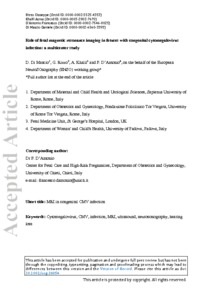Di Mascio, D; Rizzo, G; Khalil, A; D'Antonio, F; on the behalf of the European NeuroSOnography (ENSO) working gro
(2023)
Role of fetal magnetic resonance imaging in fetuses with congenital cytomegalovirus infection: a multicenter study.
Ultrasound Obstet Gynecol, 61 (1).
pp. 67-73.
ISSN 1469-0705
https://doi.org/10.1002/uog.26054
SGUL Authors: Khalil, Asma
![[img]](https://openaccess.sgul.ac.uk/114890/1.hassmallThumbnailVersion/Ultrasound%20in%20Obstet%20Gyne%20-%202022%20-%20Di%20Mascio%20-%20Role%20of%20fetal%20magnetic%20resonance%20imaging%20in%20fetuses%20with%20congenital.pdf)  Preview |
|
PDF
Accepted Version
Available under License ["licenses_description_publisher" not defined].
Download (387kB)
| Preview
|
Abstract
OBJECTIVE: To investigate the role of fetal brain MRI in detecting anomalies in fetuses with congenital CMV infection undergoing neurosonography. METHODS: Multicenter, retrospective, cohort study involving 11 referral fetal medicine centers in Italy from 2012. The inclusion criteria were fetuses with congenital CMV infection diagnosed by PCR analysis of amniotic fluid, detailed multiplanar assessment of the fetal brain as recommended by the International Society of Ultrasound in Obstetrics and Gynecology (ISUOG), normal karyotype and MRI performed within 3 weeks from the last ultrasound examination. The primary outcome was the rate of central nervous system (CNS) anomalies detected exclusively on MRI and confirmed after birth or autopsy in fetuses with a prenatal diagnosis of congenital CMV infection and normal neurosonographic assessment at diagnosis. Additional CNS anomalies were classified into anomalies of the ventricular and the periventricular zone, intra-cranial calcifications in the basal ganglia or geminal matrix, destructive encephalopathy in the white matter, malformations of cortical development, delayed myelinization, midline, posterior and complex brain anomalies. Univariate and multivariate logistic regression analysis were used to identify and adjust for potential confounders. RESULTS: The analysis included 95 fetuses with a prenatal diagnosis of congenital CMV infection and normal neurosonography at first examination. The rate of structural anomalies detected exclusively at fetal MRI was 10.5% (10/95). When considering the type of anomaly, malformations of cortical development were detected at MRI in 40% (4/10) of fetuses, destructive encephalopathy in 20% (2/10), intracranial calcifications in the germinal matrix in 10% (1/10), and complex anomalies in 30% (3/10). At the multivariate logistic regression analysis, only CMV viral load in the amniotic fluid >100,000 copies/ml (OR: 12.0, 95% CI 1.2-124.7, p=0.04) was independently associated with the likelihood of detecting fetal anomalies at MRI, while maternal age (p=0.62), maternal body mass index (BMI) (p=0.73), maternal primary CMV infection (p=0.31), first trimester infection (p=0.685), prenatal therapy (p=0.11), or the interval between ultrasound and MRI (p=0.27) were not. Associated anomalies were detected exclusively at birth and missed at both types of prenatal imaging in 3.8% (3/80) of fetuses with congenital CMV infection. CONCLUSIONS: Fetal brain MRI can detect additional anomalies in a significant proportion of fetuses with congenital CMV infection and negative neurosonography. Viral load in the amniotic fluid was an independent predictor of the risk of associated anomalies in these fetuses. The findings from the study support a longitudinal evaluation using fetal MRI in congenital CMV infection even in cases with negative neurosonography at diagnosis. This article is protected by copyright. All rights reserved.
| Item Type: |
Article
|
| Additional Information: |
This is the peer reviewed version of the following article: Di Mascio, D., Rizzo, G., Khalil, A., D'Antonio, F. and (2023), Role of fetal magnetic resonance imaging in fetuses with congenital cytomegalovirus infection: multicenter study. Ultrasound Obstet Gynecol, 61: 67-73, which has been published in final form at https://doi.org/10.1002/uog.26054. This article may be used for non-commercial purposes in accordance with Wiley Terms and Conditions for Use of Self-Archived Versions. This article may not be enhanced, enriched or otherwise transformed into a derivative work, without express permission from Wiley or by statutory rights under applicable legislation. Copyright notices must not be removed, obscured or modified. The article must be linked to Wiley’s version of record on Wiley Online Library and any embedding, framing or otherwise making available the article or pages thereof by third parties from platforms, services and websites other than Wiley Online Library must be prohibited. |
| Keywords: |
CMV, Cytomegalovirus, MRI, hearing loss, infection, neurosonography, ultrasound, on the behalf of the European NeuroSOnography (ENSO) working group, 1114 Paediatrics and Reproductive Medicine, Obstetrics & Reproductive Medicine |
| SGUL Research Institute / Research Centre: |
Academic Structure > Molecular and Clinical Sciences Research Institute (MCS) |
| Journal or Publication Title: |
Ultrasound Obstet Gynecol |
| ISSN: |
1469-0705 |
| Language: |
eng |
| Dates: |
| Date | Event |
|---|
| 3 January 2023 | Published | | 3 September 2022 | Published Online | | 12 August 2022 | Accepted |
|
| Publisher License: |
Publisher's own licence |
| PubMed ID: |
36056700 |
 |
Go to PubMed abstract |
| URI: |
https://openaccess.sgul.ac.uk/id/eprint/114890 |
| Publisher's version: |
https://doi.org/10.1002/uog.26054 |
Statistics
Item downloaded times since 07 Oct 2022.
Actions (login required)
 |
Edit Item |



